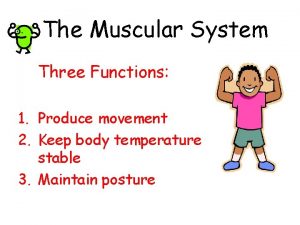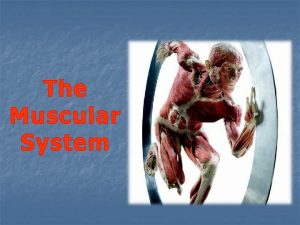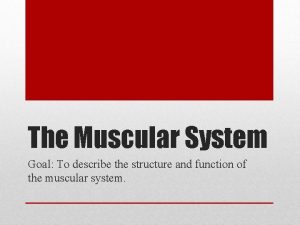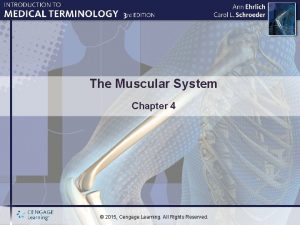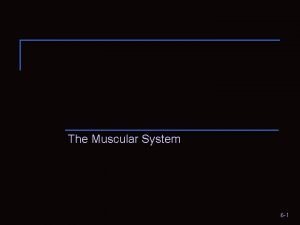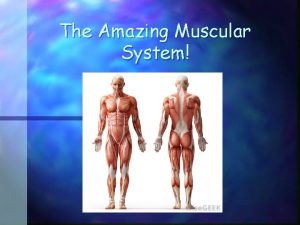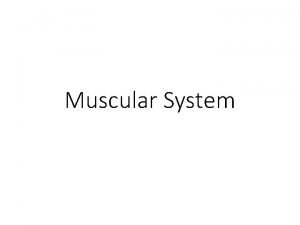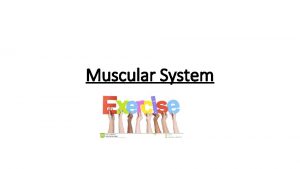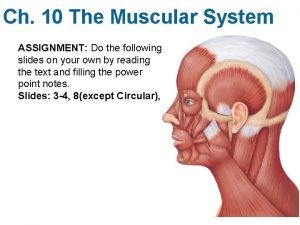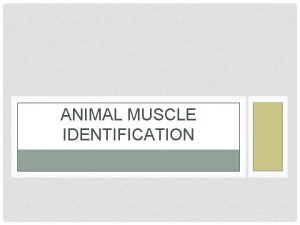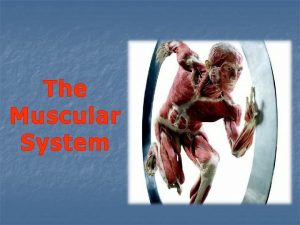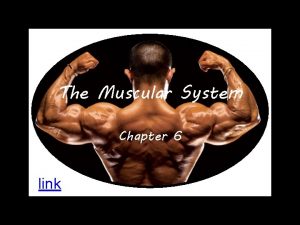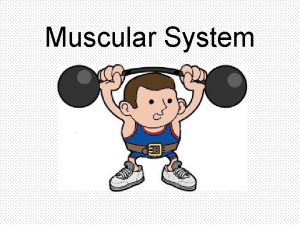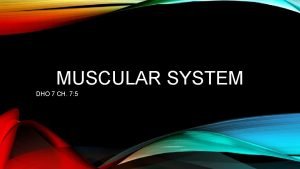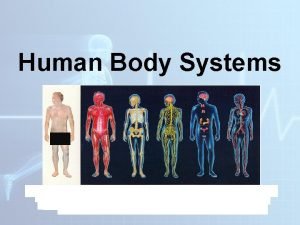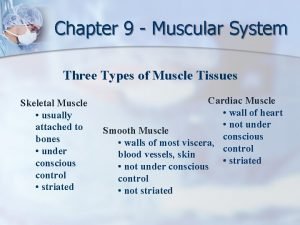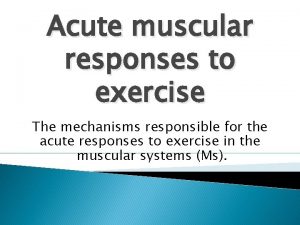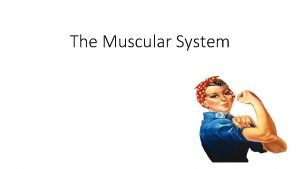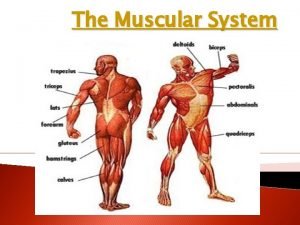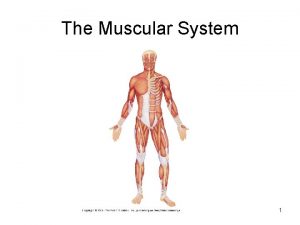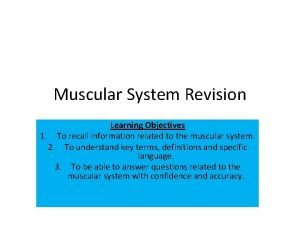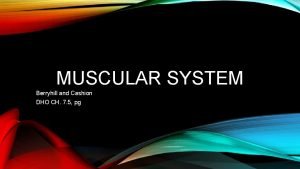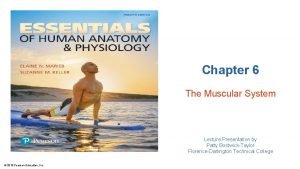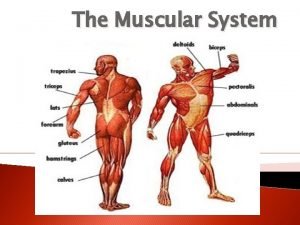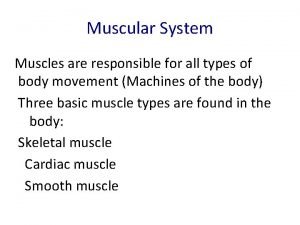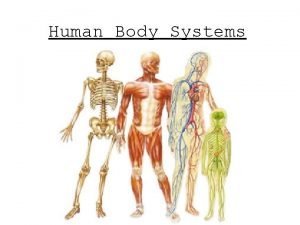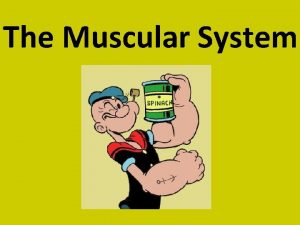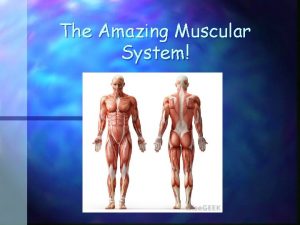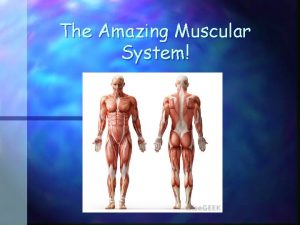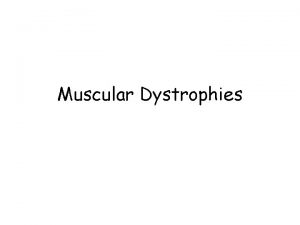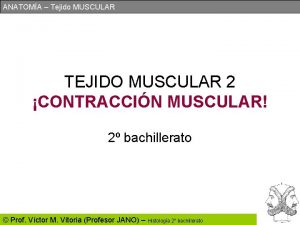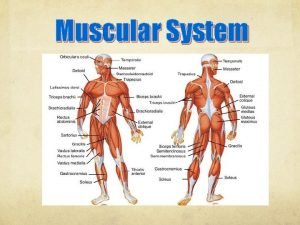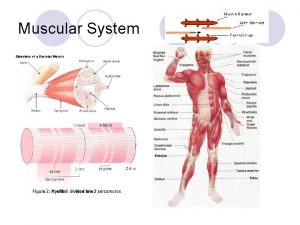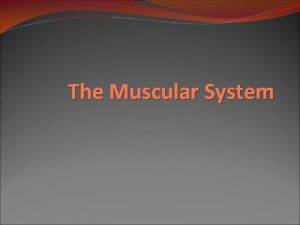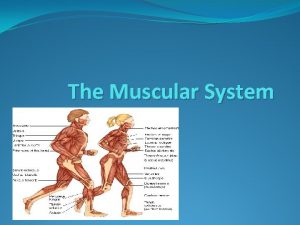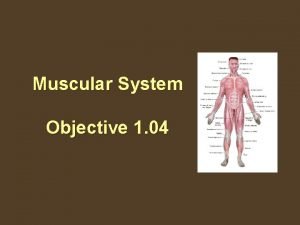Muscular System 1 I Introduction to the Muscular













































































- Slides: 77

Muscular System 1

I. Introduction to the Muscular System A. Functions of Muscular System 1. Skeletal muscle tissue forms skeletal muscles, organs that also contain connective tissue, nerves and blood vessels. 2

3

2. The muscular system includes approximately 700 skeletal muscles. 3. There are five functions of the muscular system they are: 4

a. Produce movement b. Maintain posture and body position c. Support soft tissue d. Guard entrance and exits e. Maintain body temperature 5

B. Anatomy of Skeletal Muscles 1. There are three types of muscles in the body: smooth, cardiac and skeletal, all differ in structure and function. All muscle tissues posses some basic characteristics and properties. 2. Irritability- Muscle tissue receives and responds to a stimulus from a nerve impulse. 6

Smooth Muscle 7

Skeletal muscle 8

Cardiac Muscle 9

3. Contractility- Muscle tissue responds to a stimulus by contracting, or shortening its length. 4. Extensibility- after muscles has contracted or shortened they go back to their regular length. 5. Elasticity, A muscle tissue has an innate tension that causes it to assume a desired shape regardless of how it might be stretched. 10

C. Development of Skeletal Muscles 1. The formation of the muscular system begins about 4 weeks of embryonic development. The beginning cells are called myobasts. 2. It is not certain when skeletal muscles are able to move but by the 17 th week the fetal movements- quickening are strong enough for the mother to feel. 11

12

D. Attachment 1. Skeletal muscles are usually long and narrow, span a joint, and are attached to a bone at either end by a tendon. 2. As the muscle contracts, one of the bones moves relative to the other joint. 3. The more fixed, or stationary, attachment is designated as the origin of a muscle, whereas the movable end is its insertion. 13

4. The fleshy, thickened portion of a muscle is referred to as its belly, or gaster. 5. Usually the belly of a muscle is located on the proximal bone that is to be moved. 14

15

6. The joint is spanned by a tendon from the muscle 7. A tendon is toughened, dense fibrous connective tissue that connects a muscle to the periosteum of a bone. 16

Joke Time 17

II. Muscle Mechanics A. The individual muscle cells in muscle tissue are tied together and surrounded by connective tissue. 1. 1. When muscle cells contract they pull producing tension. 2. Tension applied to an object tends to pull the object to the tension. 18

3. Resistance is a passive force that opposes the movement. 4. Compression, or a push applied to an object, tends to force the object away from the source of compression. 5. Muscles that contract together and are coordinated in accomplishing a particular movement are said to be synergistic. 19

6. Antagonistic muscles perform opposite functions and are generally located on the opposite sides of the limb. 7. Example-Biceps contract together (flex) and the triceps extend (relaxes) 20

21

Joke Time 22

8. An entire skeletal muscle contract when its components muscle fibers are stimulated. Two things determine the amount of tension produced in the skeletal muscle as a whole. -The frequency of stimulation -The number of muscle fibers activated 23

B. The frequency of Muscle Fiber stimulation 1. A twitch is a single stimulus contractionrelaxation sequence in a muscle fiber. 2. The latent period begins at stimulation and typically lasts about 2 msec. No tension is produced by the muscle fiber. 24

3. The contraction phase, tension rises to a peak. Maximum tension is reached roughly 15 msec after stimulation. 4. During relaxation phase, muscle tension falls to resting levels. This phase continues for about 25 msec. 25

III. The Energetics of Muscular Activity A. Muscle contraction requires large amounts of energy. Example- an active skeletal muscle fiber may require 600 TRILLION ATP molecules EACH second! 26

1. The primary function of ATP is the transfer of energy from one location to another, not the longterm storage of energy. 2. At rest, a skeletal muscle fiber produces more ATP than it needs. 3. Under these conditions, ATP transfers energy to creatine. 27

28

29

4. The energy transfer creates another highenergy compound, creatine phosphate (CP) C. Glycolysis and ATP generation-SEE HANDOUT and BOARD!!! 30

Joke Time 31

B. Muscle Fatigue 1. A skeletal muscle fiber is said to be fatigued when it can no longer contract despite continued neural stimulation. 2. Muscle fatigue is caused by the exhaustion of energy reserves or builds up of lactic acid. 32

33

Boston Marathon 34

35

3. If muscle contraction uses ATP at or below the maximum rate of mitochondria ATP generation, the muscle fiber can function aerobically. 4. Fatigue will NOT occur until glycogen and other reserves such as lipids and amino acids are depleted. 36

Joke Time 37

5. This type of fatigue affects the muscles of long-distance athletes, such as marathon runners, after hours of exertion. 6. When a muscle produces a sudden, intense burst of activity, the ATP is provided by glycolysis. 38

7. After a relatively short time (seconds to minutes) the rising lactic acids levels lower the tissue p. H and the muscle can no longer function normally. 8. Athletes running sprints have this type of fatigue 39

C. The Recovery Period 1. During the recovery period, conditions inside the muscle are returned to normal pre-exertion levels. 2. The muscle’s metabolic activity focuses on the removal of lactic acid and the replacement of intracellular energy reserves, and the body as a while loses the heat generated during intense muscular contraction. 40

3. The reaction that converts pyruvic acid is freely reversible. 4. During the recovery period, when lactic acid concentration is high, the lactic acid is converted back to pyruvic acid. 5. This pyruvic acid can be used 1 - to synthesize glucose and 2 - to generate ATP through mitochondrial activity. 41

6. During the recovery period, the body’s oxygen demand remains above normal resting levels. 7. The additional oxygen required during the recovery period to restore the normal preexertion levels is called an oxygen debt. 42

Joke Time 43

8. Liver cells consume most of the extra oxygen, as they produce ATP for the conversion of lactic acid back to glucose, and by muscle cells as they restore their reserves of ATP. 9. While the oxygen debt is being repaid, breathing rate and depth are increased. This is why you continue to breath heavy after 44 exercising.

D. Muscle Performance 1. Muscle performance can be considered in terms of power, the maximum amount of tension produced by a particular muscle or muscle groups. 2. Endurance the amount of time for which the individual can perform a particular activity. 45

3. Two major factors determine the performance capabilities of particular skeletal muscle 1 - types of muscle fibers and 2 - physical conditioning or training. 46

Joke Time 47

E. Types of skeletal muscle fibers 1. There are two types of fibers- fast and slow. 2. Most of the skeletal muscle fibers in the body are fast fibers because they can contract in 0. 10 seconds or less following stimulation. 48

3. Slow fibers take three times longer to contract; however, they can continue contracting for extended periods after a fast muscle would have become fatigued. 4. Three specializations related to the availability of oxygen and their uses make this possible 1 - oxygen supply 2 - oxygen storage 3 - oxygen use. 49

F. Physical conditioning 1. Physical conditioning and training schedules enables athletes to improve both power and endurance. 2. Anaerobic endurance is the length of time muscle contractions can be supported by Glycolysis and existing energy of ATP. Example- 50 -yard dash. 50

3. Athletes training to develop anaerobic endurance perform frequent, brief, intensive workouts. 4. The net effect is an enlargement, or hypertrophy of the stimulated muscle as seen in weight lifters or body builders. 51

5. Aerobic endurance is the length of time a muscle can continue to contract while being supported by mitochondrial activities. 6. Aerobic endurance is determined by the availability of substrates for aerobic metabolism from the breakdown of carbohydrates, lipids or amino acids. 52

Joke time 53

IV. Cardiac and Smooth muscle tissues A. Cardiac muscle tissue 1. Cardiac muscle cells are relatively small and usually have a single, centrally placed nucleus. Cardiac muscle tissue is found only in the heart. 2. Cardiac muscle tissue contrast WITHOUT stimulation-automatic. Pacemaker cells normally determine the timing of contractions. 54

3. Cardiac muscle cell contractions last roughly 10 times as long as those of skeletal muscle fibers. 4. Cardiac muscle cells rely on aerobic metabolism for the energy needed to continue to contract. 55

B. Smooth Muscle tissue 1. Smooth muscle tissue is found within almost every organ. 56

V. Anatomy of the Muscular System A. The muscular system includes all of the skeletal muscles that can be controlled voluntarily. B. Each muscle begins at an origin, ends at an insertion, and contract to produce a specific action. 57

1. The origin end remains stationary while the insertion moves. 2. When muscles contract, they may produce flexion, extension, adduction, abduction, protraction, retraction, elevation, depression, rotation, circumduction, pronation, supination, inversion or eversion. 58

3. Actions of muscles may be described in two ways- 1 - actions in terms of bone affected (flexion of the forearm). 2 - describes muscle action in terms of joint involvement. (Flexion at elbow) 4. Muscles can be described by their primary actions: 59

a. Prime mover or agonist: chiefly responsible for producing a particular movement. b. Antagonists- Muscles whose actions oppose the movement produced by another muscle. c. Synergist- A muscle that helps the prime mover to work efficiently. May provide additional pull near the insertion or stabilize the point of origin. 60

5. Fixators are synergists that stabilize the origin of a prime mover by preventing movement at another joint. C. Naming of skeletal muscles. 61

1. The human body has approximately 700 muscles, which all have names. 2. The names of muscles give clues to the locations of the muscles. 3. The first part of man names indicates the origin and the second part the insertion of the muscle. 62

VI. The Axial Muscles A. The axial muscles fall into four logical groups based on location function or both. 1. The muscles of the head and neck. These muscles are responsible for facial expression, chewing and swallowing. 2. The muscles of the spine. These include flexors and extensors of the head, neck and spinal column. 63

3. Muscles of the trunk. Form the muscular walls of the thoracic and abdominopelvic cavities. 4. Muscles of the pelvic floor. Extend between the sacrum and pelvic girdle. 64

VII. The appendicular Muslces A. Includes the muscles of the shoulders and upper limbs and the muscles of the pelvic girdle and lower limbs. 65

A. Aging and the Muscular system 1. Skeletal muscles become smaller in diameter. 2. Skeletal muscles become less elastic. 3. The tolerance for exercise decreases. 4. The ability to recover from muscular injuries decrease. 66

67

Joke Time 68

B. Integration with other systems. 1. To operate at maximum efficiency, the muscular system must be supported by many other systems. Such as the cardiac system, respiratory, Integumentary, nervous and endocrine system. 69

IX. Clinical considerations A. Problems with the muscular system. 1. Muscular Dystrophy is an inherited disease, which cause progressive muscular weakness and deterioration. 70

71

1. When death occurs, circulation ceases and the skeletal muscles are deprived of oxygen. Causing stiffness of the muscles. 2. A hernia develops when an organ protrudes through an abnormal opening in the surrounding cavity wall. 72

73

74

Umbilical hernia 75

Epigastric hernia 76

The End 77
 Differentiate muscular strength from muscular endurance
Differentiate muscular strength from muscular endurance Hát kết hợp bộ gõ cơ thể
Hát kết hợp bộ gõ cơ thể Slidetodoc
Slidetodoc Bổ thể
Bổ thể Tỉ lệ cơ thể trẻ em
Tỉ lệ cơ thể trẻ em Voi kéo gỗ như thế nào
Voi kéo gỗ như thế nào Thang điểm glasgow
Thang điểm glasgow Hát lên người ơi
Hát lên người ơi Môn thể thao bắt đầu bằng từ chạy
Môn thể thao bắt đầu bằng từ chạy Thế nào là hệ số cao nhất
Thế nào là hệ số cao nhất Các châu lục và đại dương trên thế giới
Các châu lục và đại dương trên thế giới Công thức tính thế năng
Công thức tính thế năng Trời xanh đây là của chúng ta thể thơ
Trời xanh đây là của chúng ta thể thơ Cách giải mật thư tọa độ
Cách giải mật thư tọa độ Phép trừ bù
Phép trừ bù độ dài liên kết
độ dài liên kết Các châu lục và đại dương trên thế giới
Các châu lục và đại dương trên thế giới Thơ thất ngôn tứ tuyệt đường luật
Thơ thất ngôn tứ tuyệt đường luật Quá trình desamine hóa có thể tạo ra
Quá trình desamine hóa có thể tạo ra Một số thể thơ truyền thống
Một số thể thơ truyền thống Cái miệng nó xinh thế chỉ nói điều hay thôi
Cái miệng nó xinh thế chỉ nói điều hay thôi Vẽ hình chiếu vuông góc của vật thể sau
Vẽ hình chiếu vuông góc của vật thể sau Thế nào là sự mỏi cơ
Thế nào là sự mỏi cơ đặc điểm cơ thể của người tối cổ
đặc điểm cơ thể của người tối cổ V cc
V cc Vẽ hình chiếu đứng bằng cạnh của vật thể
Vẽ hình chiếu đứng bằng cạnh của vật thể Tia chieu sa te
Tia chieu sa te Thẻ vin
Thẻ vin đại từ thay thế
đại từ thay thế điện thế nghỉ
điện thế nghỉ Tư thế ngồi viết
Tư thế ngồi viết Diễn thế sinh thái là
Diễn thế sinh thái là Các loại đột biến cấu trúc nhiễm sắc thể
Các loại đột biến cấu trúc nhiễm sắc thể Thế nào là số nguyên tố
Thế nào là số nguyên tố Tư thế ngồi viết
Tư thế ngồi viết Lời thề hippocrates
Lời thề hippocrates Thiếu nhi thế giới liên hoan
Thiếu nhi thế giới liên hoan ưu thế lai là gì
ưu thế lai là gì Hổ đẻ mỗi lứa mấy con
Hổ đẻ mỗi lứa mấy con Sự nuôi và dạy con của hươu
Sự nuôi và dạy con của hươu Sơ đồ cơ thể người
Sơ đồ cơ thể người Từ ngữ thể hiện lòng nhân hậu
Từ ngữ thể hiện lòng nhân hậu Thế nào là mạng điện lắp đặt kiểu nổi
Thế nào là mạng điện lắp đặt kiểu nổi How do muscles move
How do muscles move What is the primary function of the muscular system
What is the primary function of the muscular system 2 function of muscular system
2 function of muscular system Chapter 4 the muscular system
Chapter 4 the muscular system Chapter 6 the muscular system figure 6-9
Chapter 6 the muscular system figure 6-9 Simple muscular system diagram
Simple muscular system diagram Greek and latin roots jeopardy
Greek and latin roots jeopardy Muscular system label
Muscular system label Chapter 6 the muscular system
Chapter 6 the muscular system Muscular system assignment
Muscular system assignment Sheep muscular system
Sheep muscular system Navigating the body movements of the body #1
Navigating the body movements of the body #1 Whats the function of the muscular system
Whats the function of the muscular system Chapter 6 the muscular system figure 6-9
Chapter 6 the muscular system figure 6-9 Purpose of muscular system
Purpose of muscular system 7:5 muscular system
7:5 muscular system Chapter 9 muscular system
Chapter 9 muscular system Sarcomore
Sarcomore Sarcromeres
Sarcromeres Chapter 32 section 3 the muscular system answer key
Chapter 32 section 3 the muscular system answer key Muscular system response to exercise
Muscular system response to exercise Whats the muscular system
Whats the muscular system Major muscles
Major muscles Microscopic anatomy of skeletal muscle figure 6-2
Microscopic anatomy of skeletal muscle figure 6-2 Muscular system levels of organization
Muscular system levels of organization Superficial muscular system
Superficial muscular system Anatomy of a pig
Anatomy of a pig Muscular system learning objectives
Muscular system learning objectives Chapter 7:5 muscular system
Chapter 7:5 muscular system Chapter 6 the muscular system
Chapter 6 the muscular system Chapter 4 the muscular system
Chapter 4 the muscular system What are the major functions of the muscular system
What are the major functions of the muscular system I band h zone
I band h zone 3 functions of the muscular system
3 functions of the muscular system Esternocleidomastoideo
Esternocleidomastoideo











































